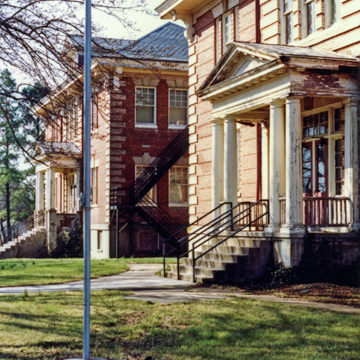You are here
Maple Manor Apartments (Chase City Grade School and High School)
This matched pair of schools is in a freewheeling Georgian Revival by Huggins of Roanoke. The two-story, red brick buildings with dormers in their hipped roofs have contrasting cream-colored brick quoins and keystoned jack arches. Entrance to each building is through a single-story Doric portico with paired columns. The schools were built during Virginia's “education renaissance” at the turn of the twentieth century when a public high school system was being established. In 1906 the Virginia General Assembly passed the Mann High School bill, which obligated the state to provide matching funds to districts that built a high school. Two hundred and eighty-five new schools were built over the next four years. In 1991 the schools here were renovated as apartments for the elderly.
Writing Credits
If SAH Archipedia has been useful to you, please consider supporting it.
SAH Archipedia tells the story of the United States through its buildings, landscapes, and cities. This freely available resource empowers the public with authoritative knowledge that deepens their understanding and appreciation of the built environment. But the Society of Architectural Historians, which created SAH Archipedia with University of Virginia Press, needs your support to maintain the high-caliber research, writing, photography, cartography, editing, design, and programming that make SAH Archipedia a trusted online resource available to all who value the history of place, heritage tourism, and learning.















